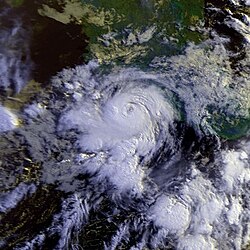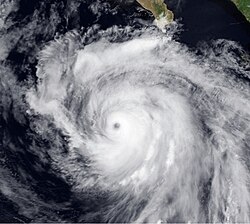1996 Pacific hurricane season
Period of formation of tropical cyclones in the Eastern Pacific Ocean in 1996 From Wikipedia, the free encyclopedia
Remove ads
The 1996 Pacific hurricane season was an event in tropical cyclone formation and the second least active Pacific hurricane season in recorded history, behind only 1977. It officially began May 15, 1996 in the eastern north Pacific and on June 1, 1996 in the central north Pacific. It ended on November 30, 1996. These dates conventionally delimit the period of each year when most tropical cyclones form in the northeastern Pacific Ocean.
Remove ads
Few notable storms formed this season, however it was very eventful. Twelve tropical cyclones formed during this season, of which five made landfall and two other impacted land areas. Two tropical cyclones that formed in other basins entered the eastern north Pacific Ocean. Early in the season three tropical cyclones impacted Mexico in a ten-day span, while the first cyclone of the season formed before it officially began. Hurricane Douglas was the strongest storm, reaching Category 4 intensity on the Saffir-Simpson Hurricane Scale and had its beginnings in the Atlantic as Hurricane Douglas.
Remove ads
Timelinə

Storms
Hurricane Alma
Alma was the first of three consecutive storms to come close to, or make landfall on, the Pacific coast of Mexico during a ten-day span. Alma killed at least three people, and possibly twenty. Three were killed when a house near Lazaro Cardenas collapsed. There were unconfirmed reports that 17 people were killed by floods in Puebla from rains related to Alma. Trees were downed and power was knocked out to many places. Roads were flooded and covered with Debris.
Hurricane Boris
Hurricane Boris was the second consecutive storm to approach close to Mexico. It made landfall halfway between Acapulco and Lazaro Cardenas on June 29. It killed ten people. A flood caused by Boris on the San Jeronimo River left thousands homeless.
Tropical Storm Cristina
Cristina was the third cyclone to come close to Mexico in the space of ten days. It killed a fisherman when his boat was caught at sea off Oaxaca. At least 11 other fishing boats and 22 people were missing. Their fate is unknown.
Hurricane Douglas
Hurricane Douglas was a continuation of Atlantic Hurricane Cesar, which crossed Central America. Continuing Cesar's nearly due-west heading, it was still a tropical storm when it entered the Pacific on July 29, and quickly regained hurricane status.[1]
Douglas's strengthened over the next two days as it turned west-northwest, paralleling the coast of Mexico. It reached its peak intensity on August 1, with winds of 115 knots (130 mph; 215 km/h) and a central pressure of 946 mbar (27.94 inHg), making it the strongest hurricane of the season.[1] Its slow weakening began on August 2 as it entered cooler waters, and it officially dissipated on August 6, though like many Pacific hurricanes, a remnant circulation could be tracked westward for several days afterward.[1]
Hurricane Fausto
The precursor disturbance to Fausto was first noticed over Venezuela as early as August 31, and may have been related to the tropical wave that spawned Hurricane Fran.[2] By September 4 the wave had crossed Central America into the Pacific; it steadily organized until it was upgraded to Tropical Storm Fausto on September 10.[2]
Fausto intensified rapidly after it reached hurricane intensity on the 12th, peaking with sustained winds of 105 knots (120 mph; 195 km/h) and a minimum central pressure of 955 mbar (28.20 inHg).[2] The hurricane weakened as an approaching trough increased shear over the storm; this same trough also turned the storm north on the 13th, where it made landfall as a minimal hurricane Baja California that day.[2] On September 14, the storm turned northeastward across the Gulf of California, and dissipated inland over the Sierra Madre range after its second landfall as a hurricane.[2] Its extratropical remnants flared up briefly over northern Mexico and Texas, but otherwise soon lost their identity.
Damage in Mexico was relatively minor, with only a single casualty caused by a downed power line.[2]
Hurricane Hernan
Hurricane Hernan made landfall in a thinly-populated region of Mexico. It washed out roads, and knocked down power lines and telephone poles. There were 100 injuries but no deaths.
Remove ads
References
Wikiwand - on
Seamless Wikipedia browsing. On steroids.
Remove ads













